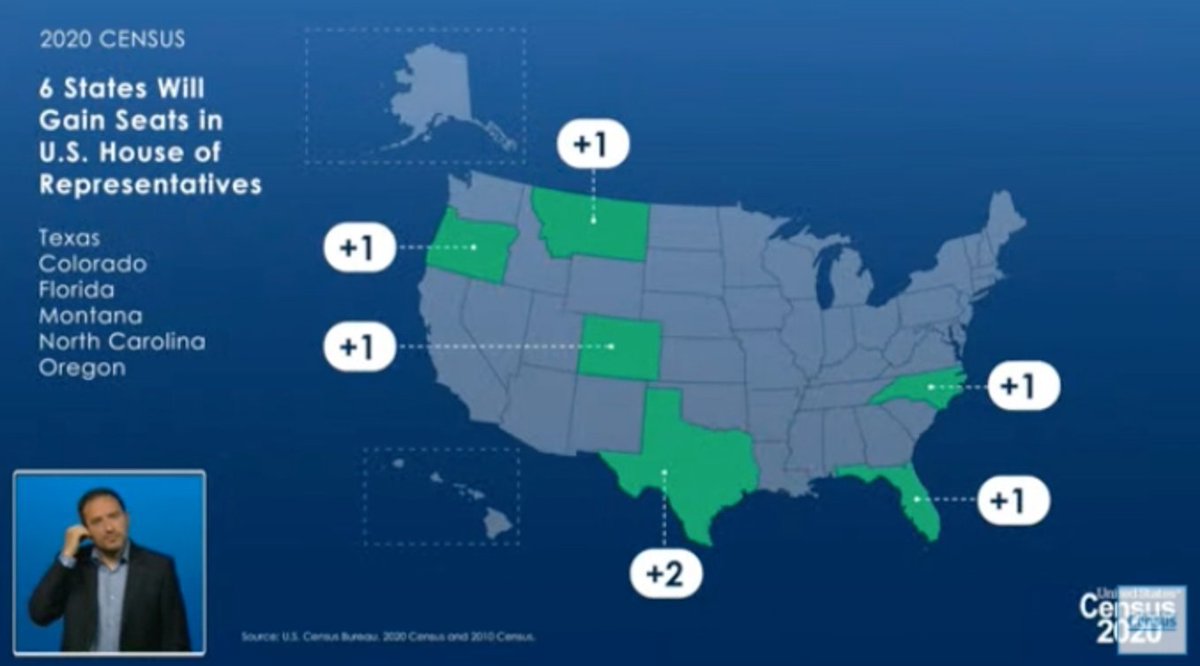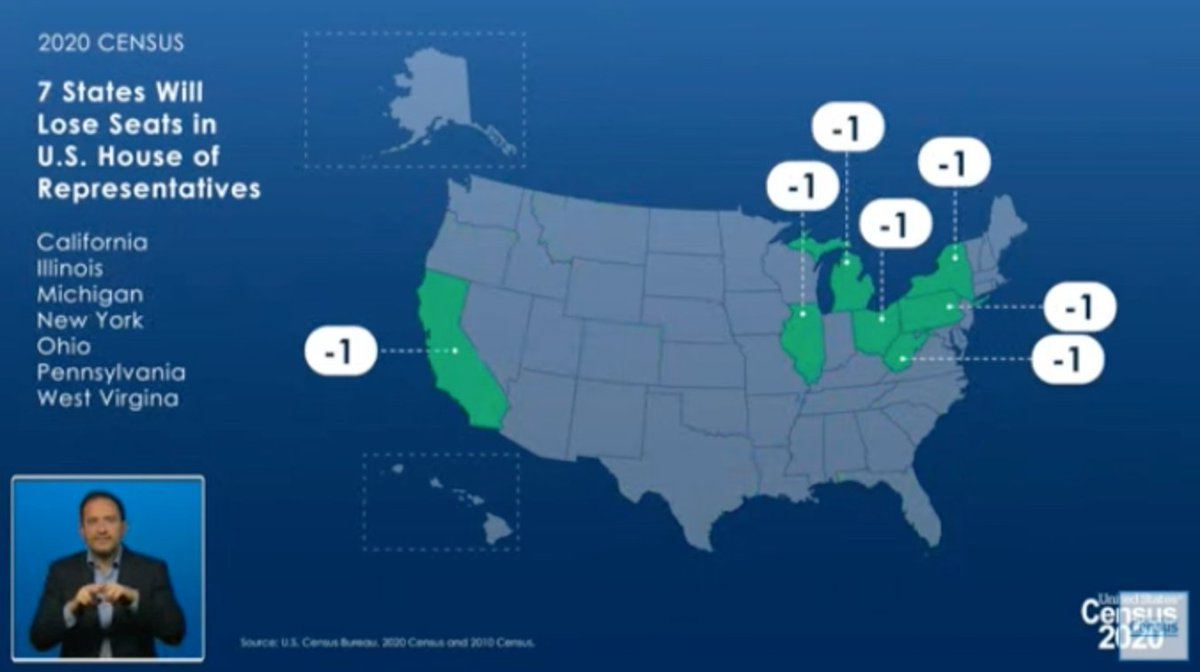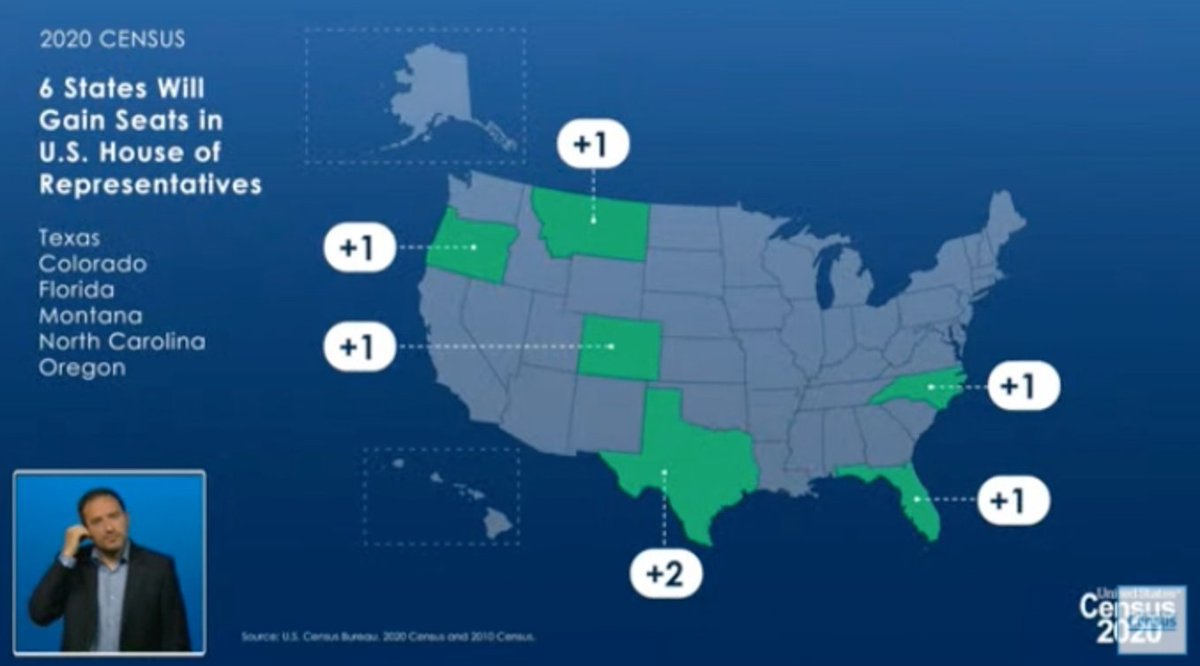News reports are saying the Census& #39;s reapportionment numbers are a gain for Republicans, a loss for Democrats. A short thread on why this is not entirely true - and why the biggest uncertainties lie ahead, in redistricting.
The claim is that Biden states lost 3 seats net, and Trump states gained 3. But this does not nearly tell the whole story. Instead, one has to examine the redistricting landscape. Warning: nerdery ahead.
Gaining: MT, OR, CO, FL, TX (2), NC.
Losing: CA, MI, IL, OH, PA, WV, NY.
Gaining: MT, OR, CO, FL, TX (2), NC.
Losing: CA, MI, IL, OH, PA, WV, NY.
This is the smallest change in seats since 1920, when reapportionment failed entirely, thanks to rural representatives blocking the entire process in order to avoid losing power. The next-closest was 1940, when 9 seats changed. So 7 seats is not a a lot. https://www.census.gov/data/tables/time-series/dec/apportionment-data-text.html">https://www.census.gov/data/tabl...
First, the losses.
California and West Virginia each lose a seat. They will probably eliminate a Democratic and Republican seat, respectively. Net change: zero.
California and West Virginia each lose a seat. They will probably eliminate a Democratic and Republican seat, respectively. Net change: zero.
Two states that lose 1 seat each already have strongly partisan delegations: Illinois (13 D, 5 R) and Ohio (12 R, 4 D). So lopsided that the majority will probably lose a seat. Net change: zero.
(OH has Fair Districting laws, which will also influence the outcome. Important!)
(OH has Fair Districting laws, which will also influence the outcome. Important!)
PA is far more likely to be 9 D, 8 R than 9 R, 8 D. Minus one for Democrats.
NY loses a seat, but Democrats are in charge of line-drawing. Minus one for Republicans.
Net change: zero.
NY loses a seat, but Democrats are in charge of line-drawing. Minus one for Republicans.
Net change: zero.
(Pennsylvania& #39;s Congressional delegation is currently 9 R, 9 D. It& #39;s a famously 50-50 state, and redistricting is done by statute - and is bipartisan this year. Given the geography of Pennsylvania, it& #39;s hard to imagine eliminating a Republican seat.)
Michigan: hard to predict. An independent redistricting commission will undo the 2012 gerrymander. It& #39;s not clear what the next change will be - I will score this as a net change of zero.
However, note that citizen input is critical here. Get involved! https://www.michigan.gov/micrc ">https://www.michigan.gov/micrc&quo...
However, note that citizen input is critical here. Get involved! https://www.michigan.gov/micrc ">https://www.michigan.gov/micrc&quo...
OK, so the net change from lost seats is zero for either party. Some uncertainties - but they are under the control of citizen input. So the real action item is: get involved locally! Report your communities of interest!
A place to start: http://Representable.org"> http://Representable.org
A place to start: http://Representable.org"> http://Representable.org
Now, the states that gained seats.
Again, they are
Montana
Oregon
Colorado
North Carolina
Florida
Texas (2)
Again, they are
Montana
Oregon
Colorado
North Carolina
Florida
Texas (2)
Colorado& #39;s Congressional delegation is 4 Democrats, 3 Republicans. In November, Biden defeated Trump by 13.5 points. An independent commission will probably add a seat that ends up Democratic.
But this will be dependent on citizen input. Get involved! https://redistricting.colorado.gov/ ">https://redistricting.colorado.gov/">...
But this will be dependent on citizen input. Get involved! https://redistricting.colorado.gov/ ">https://redistricting.colorado.gov/">...
Oregon& #39;s delegation is 4 Democrats, 1 Republican. The Democratic majority gave Republicans a seat at the table, in order to get them to stop blocking legislation. The added seat will probably tilt Republican.
So Colorado+Oregon, no net change (but better representation in both!)
So Colorado+Oregon, no net change (but better representation in both!)
Montana adds a seat. The redistricting commission there is bipartisan, with a nonpartisan chair. I would expect the western and eastern parts of the state to comprise the two districts. The westernmost district might be a swing district, winnable by either party. Net change: zero
OK, now we get to Texas, which gains two seats.
Oh, Texas, Texas.
This could be 2 seats for Republicans, or no net change. It& #39;s going to depend on details, and depends a lot on existing districting and political trends. A few points...
Oh, Texas, Texas.
This could be 2 seats for Republicans, or no net change. It& #39;s going to depend on details, and depends a lot on existing districting and political trends. A few points...
Texas& #39;s delegation is currently 23 Republicans, 13 Democrats. The GOP is already cutting it close: in 2020, six Republican members won with <53% of the vote. The state is trending Democratic: Biden 2020 gained over Clinton 2016 by 3 points, more than any other state.
So Texas legislators and Governor Abbott, all Republicans, could draw two new GOP districts - but over the span of a decade, that could backfire on them. That seems like a risky move.
It would be more prudent to draw 1 D, 1 R district.
What will they do? ...
It would be more prudent to draw 1 D, 1 R district.
What will they do? ...
Well, partisanship isn& #39;t the only factor. Communities matter - as does racial fairness. Hispanic voters in Texas are at multiple points on the political spectrum. I would say it& #39;s complicated - and citizens should weigh in - especially in greater Houston, growing so fast.
In addition, there is a serious issue with undercounting of Hispanics in this Census. The states that underperformed relative to July 2020 population estimates included Texas, Florida, Colorado, Arizona and Nevada - all Hispanic-rich states. A real risk of poor representation.
The way to address this is through citizen input. Again, tools like @Representable_, @davesredist, @DistrictBuilder, and @gerrymandr DistrictR can make citizen input far more effective. Look for one of them and use to document your community! http://Representable.org"> http://Representable.org
Finally, we come to Florida. Florida only gained one seat, short of the predicted two seats.
(Again, this may be because of the Hispanic undercount. That& #39;s an interesting story for another thread.)
But the big question mark in Florida is single-party control of redistricting.
(Again, this may be because of the Hispanic undercount. That& #39;s an interesting story for another thread.)
But the big question mark in Florida is single-party control of redistricting.
Surely the Florida legislature and governor will seek to obtain partisan advantage. Florida& #39;s Fair Districts laws offer a defense. The state Supreme Court is all-Republican. so any argument would have to focus on competition, and not just a purely partisan claim.
North Carolina also gains a seat. Now there is an issue. Redistricting is under single-party control NC Republicans will probably to repeat their tactic of drawing a gerrymander, as they did in 2012. That was heavily litigated, and overturned in state court...
But the state court is different now. 4 Republicans, 3 Democrats. And the new Chief Justice has strong ideological views. At a minimum, this will be contentious.
Rapid citizen input could make a difference here. Strong media and public attention could moderate the outcome.
Rapid citizen input could make a difference here. Strong media and public attention could moderate the outcome.
But let& #39;s say it& #39;s +1 seat for Republicans...with a lot of upside potential if they can pull off a partisan map.
Bottom line: Republicans seem likely to get a net advantage from redistricting. But it& #39;s mainly because of single-party redistricting in states like Florida and North Carolina - not b/c of reapportionment.
It comes down to redistricting, citizen input, and effective reforms.
It comes down to redistricting, citizen input, and effective reforms.
To learn more about redistricting, check out our
@princetongerry site: http://gerrymander.princeton.edu"> http://gerrymander.princeton.edu
Also, our team is ready to help you in your state. Get in touch!
/end
@princetongerry site: http://gerrymander.princeton.edu"> http://gerrymander.princeton.edu
Also, our team is ready to help you in your state. Get in touch!
/end
P.S. Overall, the Census did not undercount people. Compared with state-by-state estimates from July 2020, the median result was 0.7% higher. Impressive net result.
That said, we have to be alert for more detailed evidence of Hispanic undercounts. Essential.
That said, we have to be alert for more detailed evidence of Hispanic undercounts. Essential.
Correction: I meant that Pennsylvania is likely to become 9 Republican, 8 Democratic seats rather than the other way around. https://twitter.com/SamWangPhD/status/1387071686248263681">https://twitter.com/SamWangPh...

 Read on Twitter
Read on Twitter




